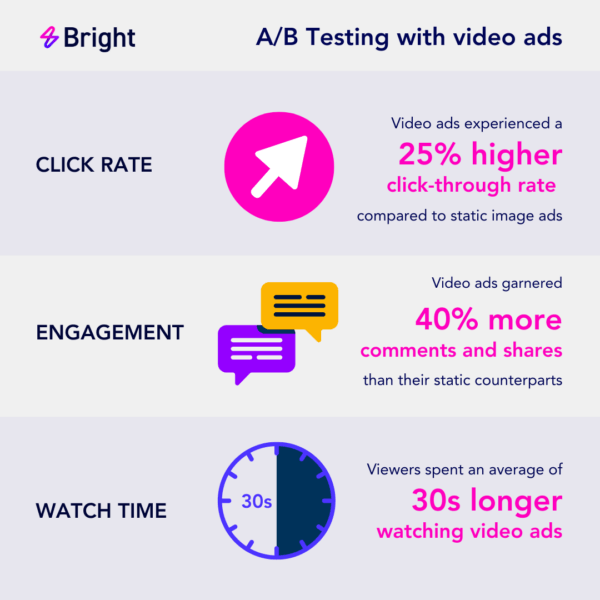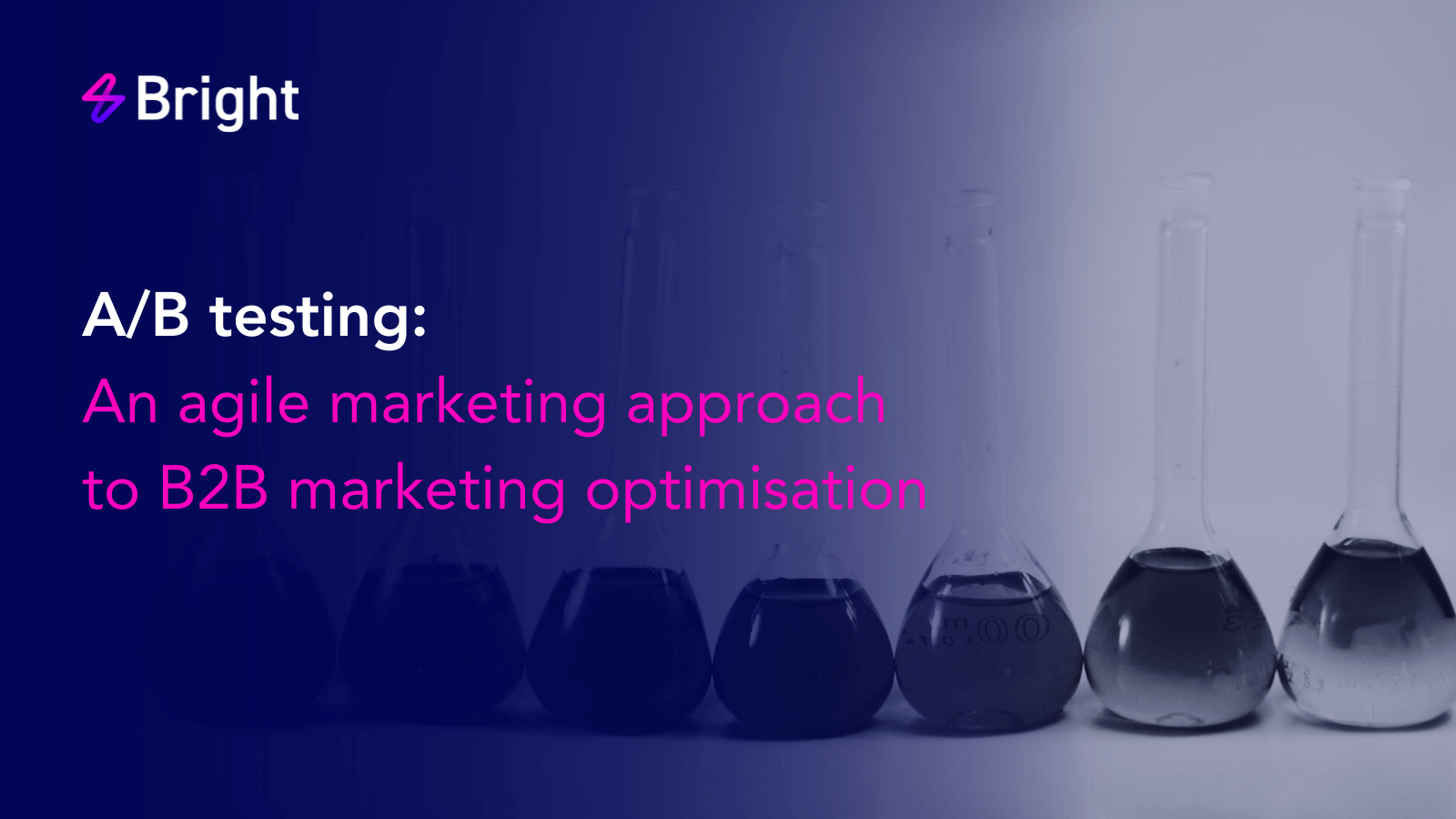Let’s face it, the B2B world is a rollercoaster. One minute, you’re riding high on a new tech trend; the next, you’re bracing for an economic downturn. It’s like trying to hit a moving target in a fog, and to make things even more interesting, there’s the constant noise of new competitors and a sea of content that’s drowning out your message. Cutting through the noise and being able to relate directly to your prospects and customers is not just a ‘nice-to-have’ but a necessity.
At Bright, we believe the key to success lies in continuous improvement and data-driven decision-making. That’s where A/B testing comes in – the best unkept secret for optimising your B2B marketing efforts in this dynamic environment. It isn’t just about why you apply A/B testing but also how you apply the methodology to make it work.
To test or not to test? That really is the question.
A/B testing, also called split testing, pits two variations of a marketing element against each other to see which one performs better. This could be anything from a landing page headline to a call-to-action button in an email. By statistically analysing the results, you gain valuable insights into what resonates with your target audience.
Here’s why A/B testing is a perfect fit for agile B2B marketing:
- Fast iteration: The agile methodology thrives on quick cycles of experimentation and learning. A/B testing allows you to test hypotheses, gather data quickly, and refine your approach based on real-world results.
- Data-driven decisions: Forget gut feelings. A/B testing removes guesswork from the equation. You’ll see concrete evidence of what works and what doesn’t, empowering you to make data-backed decisions for better ROI.
- Continuous improvement: A/B testing is an ongoing process. As you learn what resonates with your audience, you can keep iterating and optimising your marketing tactics for maximum impact.
A/B testing for B2B marketers
While A/B testing offers a powerful tool for any marketing campaign, the B2B landscape presents unique opportunities and challenges. To truly optimise your B2B marketing efforts, you need to tailor your A/B testing strategy to address the specific needs of complex customers. Here are some A/B testing ideas specifically for B2B marketing:
- Landing page optimisation:Test different headlines, CTAs, images, and layouts to see which ones drive higher conversion rates e.g. eBook downloads, demo requests.
- Email marketing:A/B test subject lines, email copy, sender names, and send times to improve open rates and click-through rates.
- Website Calls to Action:Experiment with different CTA button text, colour, and placement to see which ones get the most clicks.
- Social media ads:Test different ad creatives, headline variations, and targeting parameters to optimise your ad spend and reach the right audience.
Test. Process. Learn. Repeat
So, how can you take this one step further and implement the A/B Testing Process into your own marketing efforts? By using the principles and practices of agile marketing, you can take a structured approach to your experimentation, ensuring continuous improvement and positively impact your effectiveness.
Here’s a step-by-step breakdown of the A/B testing process, designed to operate within an agile framework:
- Identify a goal: Start with a specific goal you want to achieve,like increasing leads from a particular campaign.
- Formulate a hypothesis: What element do you think will impact that goal?(e.g., a stronger headline will increase website sign-ups)
- Create variations: Develop two versions of the element you’re testing (e.g.,Headline A vs. Headline B)
- Run the test: Split your target audience and expose them to each variation.
- Analyse results: After a statistically significant amount of data is collected,analyse the results to see which variation performed better.
- Iterate & improve: Based on your findings,refine your marketing strategy and implement the winning variation.
The Bright way
At Bright, we’re passionate about leveraging data-driven insights to optimise marketing strategies. By conducting controlled experiments, we can identify which elements of a campaign are most effective and make data-backed decisions to improve performance.
A recent case study: Social media ad formats
Recently, we had the opportunity to work with a client to determine the optimal ad format for their social media campaign. The client’s goal was to increase engagement and drive conversions.
Hypothesis: Video adverts vs. static image ads
Our hypothesis was that video adverts would outperform static image ads in terms of engagement. We reasoned that the dynamic nature of video would capture attention more effectively and lead to higher click-through rates (CTRs) and conversions.
The experiment
To test our hypothesis, we created two versions of the ad: one with a static image and the other with a short video. Both ads featured the same messaging and call to action. We then split the target audience into two groups and randomly assigned each group to see one of the ad variations.
Outcome: Video adverts triumph
The results were conclusive. The video ads significantly outperformed the static image ads in terms of engagement and CTR. Users were more likely to click on the video ads, watch them, and take the desired action.

Key Insights
- Video is a powerful tool: Video content can capture attention, tell a story, and evoke emotions in a way that static images cannot.
- Engagement matters: Higher engagement rates can lead to increased brand awareness, trust, and conversions.
- A/B testing is essential: By conducting controlled experiments, we can identify the most effective elements of a campaign and make data-driven decisions to improve performance.
Conclusion
In conclusion, this case study underscores the value of A/B testing as a strategic tool for optimising social media campaigns. By carefully experimenting with different ad formats, we were able to identify the most effective approach for our client and deliver tangible results.
The data-driven insights gleaned from this experiment not only inform future campaigns but also provide valuable benchmarks for industry standards. As social media platforms continue to evolve, A/B testing remains a cornerstone of successful marketing strategies. By pioneering innovative approaches and harnessing the potential of data, businesses can redefine their industry and achieve remarkable marketing success.
So, what are you waiting for?
Being a B2B marketer today demands constant adaptation and improvement. By embracing A/B testing as an ongoing process, you can transform your marketing efforts from a guessing game into a data-driven science. This iterative approach empowers you to refine your messaging, optimise your creative assets, and ultimately achieve superior marketing effectiveness. So, don’t be afraid to experiment, embrace the learnings from each A/B test, and watch your B2B marketing efforts soar to new heights.
Ready to take your B2B marketing to the next level? Contact us today and let’s unlock the full potential of your marketing efforts through the power of agile marketing!

